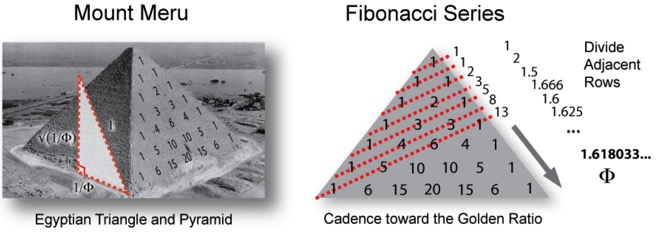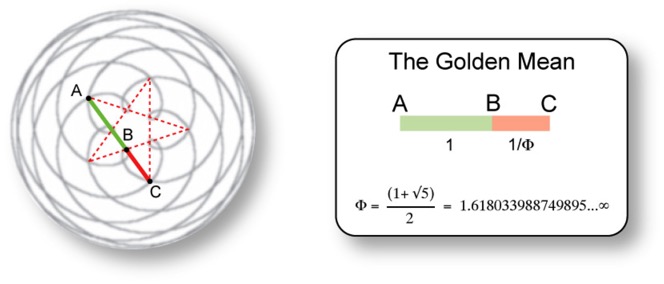Phi in Ancient Religion
27/02/12 15:07
From the earliest known scripture in the Rig-Veda, the Divine Proportion has been at the epicenter of virtually all religions. Based on astronomical observations and cosmological interpretations, this ancient text suggests the existence of a transcendental mountain named Mount Meru stretching from the deepest ocean into the furthest space where the gods lived, dancing and singing on its golden summit. The gods themselves were of course personifications of the Sun, Moon and visible planets whose orbital frequencies, patterns and conjunctive resonances with Earth created a kind of celestial music or Music of the Spheres. First described in the Rig-Veda as sruti or “what is heard,” this musical cosmology was based in large part on the golden ratio.
According to Vedic grammarian Pingala in his Art of Prosody (400-200 BC), Mount Meru was actually a symbol for the Fibonacci series converging to the golden ratio. Meru was seen as a pyramidal cadence of numbers reaching toward a central axis of gold (Fig. 1)

Figure 1. Vedic Mount Meru as a Fibonacci cadence.
As the Rig-Veda tells it, the gods were associated with the Sun (Surya), Moon (Soma), Venus (Shukra), Mercury (Budha) and other planets that passed over Meru. In particular, the Venusian god Shukra was described as hovering over the sacred mountain to protect it. This association is very important since the orbital geometry of Venus traces a pentagonal rose or star in the night sky over an 8-year period, exhibiting many near golden ratios in its intersections and retrograde loops (Fig. 2).
According to the Rig-Veda, Lord Kubera lived on top of Meru as the god of wealth and riches who valued gold above all else. To protect the gold, asuras (coiled serpents) living inside the mountain hid it in their serpent holes. But since the teacher of the asuras was Shukra, the god of Venus, it was he who commanded them to hide the gold in the mountain. As a metaphor for the Golden Ratio at the center of a Fibonacci spiral around the mountain, it was the orbital star of Venus that really paved heaven with gold.

Figure 2. The pentagonal orbit of Venus as seen from Earth over an 8-year period.
From this Vedic cosmology and its divine number came most every other religion. Best we can tell it all began with a Sanskrit-speaking Armenian Aryan tribe living in northern Turkey. Migrating southward about 5,800 years ago, it was these “noble people” who introduced the Rig-Veda to the world, bringing with it the rise of human civilization.
In Mesopotamia they founded the Sumerian civilization, named after Su-meru or “wonderful Meru.” In Ethiopia, they traveled down the Nile to establish To-Mera, the Egyptian civilization that built the Great Pyramid known as M’R or myrrh. To the east of Egypt was Amurru, the holy land of Canaan where they blended the Vedic beliefs of ancient Egypt and Mesopotamia. Later, the Babylonians created their own blend of Canaanite beliefs to worship the sky gods and their sacred mount Carmel.
Moving into the Indus Valley of northwestern India, the Aryans intermarried with the Dravidic tribes and migrated south to the tip of the pyramid-shaped Indian subcontinent. There they built many great Meru temples near Tamil Nadu (meaning tail end). The island of Sri Lanka just off the coast was even considered the golden summit of Meru that had broken off and fallen into the sea.
Migrating eastward into China, the Aryans built many earthen pyramids in honor of Meru. From this, the entire Asian continent came to adopt the Rig-Veda and its cosmology, becoming the foundation for Buddhism, Jainism and Taoism. At the same time, a growing body of evidence suggests westward voyages across the Atlantic delivered the same Vedic cosmology to the Americas. Discoveries of Old World artifacts, Sanskrit writing, pyramids of the Sun and Venus – even a god named Amuru and mountains named Amerrique – are all compelling evidence that the Rig-Veda was the inspiration behind the Mayan, Aztec, Incan, Hopi and other Native American religions.
Back in the Mediterranean, the Ithacans and Phoenicians introduced Vedic cosmology to the Greeks, who (along with the Etruscans) introduced it to the Romans. During the Holy Roman Empire, it was distributed throughout Europe in the anthropomorphic forms of Christianity. From there it sailed back to America and the rest, as they say, is history.
So, whether you call it Moriah, Carmel, Sinai, Sion, Olympus, Athos, Etna, Acropolis, Ida, Hara Berezalti, Mount Koya-san, Kailash, Machapuchare, Machu Picchu, Amerrique or Capitol Hill, you will always find a sacred Fibonacci mountain at the heart of religion. And whether you call her Shukra, Vena, Lusaaset, Hathor, Isis, Ishtar, Astarte, Inanna, Semiramis, Ashtoreth, Asherah, Demeter, Aphrodite, Venus, Libertas, Lucia, Eastre, Austro, Ostara, Freyja, Britannia, Marianne or the Columbian goddess known as Lady Liberty, you will always find a pentagonal star hovering over the sacred mountain to protect its gold and make it fertile. Honored even today in the “Christmas” Tree of Asherah, these are the symbols of the Divine Proportion that together trace back to the true origin of the world’s great religions.
Bibliography
1. Manoharlal, Munshiram. “The Astronomical Code of the Rigveda.” Publishers Pvt. Ltd (2000), ISBN 81-215-0986-6
2. Witzel, Michael. "Autochthonous Aryans? The Evidence from Old Indian and Iranian Texts", Electronic Journal of Vedic Studies, Vol. 7 (2001) issue 3 (May), §28.
3. Bryant, Edwin. “The Quest for the Origins of Vedic Culture: The Indo-Aryan Migration Debate.” Oxford University Press, 2001.
4. Abbas, Samar. “India’s Parthian Colony: On the origin of the Paliava empire of Dravidia.” www.cais-soas.com/CAIS/History/ashkanian/parthian_colony.htm
5. Fiorenza, Nick A. “The Venus Transits: The Pentagonal Cycle of Venus.” www.lunarplanner.com/HCpages/Venus.html
6. Kak, Subhash. “Vena, Veda, Venus” Brahmavidya: The Adyar Library Bulletin, vol. 60, 1996. Pp. 229-239
7. Kak, Subhash. “The Golden Mean and the Physics of Aesthetics” Foarm Magazine 5, 73-81, 2006
8. Snodgrass, Adrian. “Symbolism of the Stupa.” Cornell University Southeast Asia Program Publications; 2nd edition (March 1, 1985)
9. Tirthaji, Bharati Krsna. “Vedic Mathematics.” Motilal Banarsidass (January 1, 2000)
10. Coppens, Phillip. “The New Pyramid Age: Worldwide Discoveries of New Pyramids Challenge Our Thinking.” O Books, John Hunt (July 16, 2007), ISBN 1-846940 46 X
11. Romer, John. “The Great Pyramid: Ancient Egypt Revisited.” ISBN 9780521871662. Cambridge University Press, Cambridge (2007)
12. Merrick R.S., “Interference: A Grand Scientific Musical Theory,” (self-published), Fairview, Texas, 2009. ISBN: 978-0-615-20599-1.
According to Vedic grammarian Pingala in his Art of Prosody (400-200 BC), Mount Meru was actually a symbol for the Fibonacci series converging to the golden ratio. Meru was seen as a pyramidal cadence of numbers reaching toward a central axis of gold (Fig. 1)

Figure 1. Vedic Mount Meru as a Fibonacci cadence.
As the Rig-Veda tells it, the gods were associated with the Sun (Surya), Moon (Soma), Venus (Shukra), Mercury (Budha) and other planets that passed over Meru. In particular, the Venusian god Shukra was described as hovering over the sacred mountain to protect it. This association is very important since the orbital geometry of Venus traces a pentagonal rose or star in the night sky over an 8-year period, exhibiting many near golden ratios in its intersections and retrograde loops (Fig. 2).
According to the Rig-Veda, Lord Kubera lived on top of Meru as the god of wealth and riches who valued gold above all else. To protect the gold, asuras (coiled serpents) living inside the mountain hid it in their serpent holes. But since the teacher of the asuras was Shukra, the god of Venus, it was he who commanded them to hide the gold in the mountain. As a metaphor for the Golden Ratio at the center of a Fibonacci spiral around the mountain, it was the orbital star of Venus that really paved heaven with gold.

Figure 2. The pentagonal orbit of Venus as seen from Earth over an 8-year period.
From this Vedic cosmology and its divine number came most every other religion. Best we can tell it all began with a Sanskrit-speaking Armenian Aryan tribe living in northern Turkey. Migrating southward about 5,800 years ago, it was these “noble people” who introduced the Rig-Veda to the world, bringing with it the rise of human civilization.
In Mesopotamia they founded the Sumerian civilization, named after Su-meru or “wonderful Meru.” In Ethiopia, they traveled down the Nile to establish To-Mera, the Egyptian civilization that built the Great Pyramid known as M’R or myrrh. To the east of Egypt was Amurru, the holy land of Canaan where they blended the Vedic beliefs of ancient Egypt and Mesopotamia. Later, the Babylonians created their own blend of Canaanite beliefs to worship the sky gods and their sacred mount Carmel.
Moving into the Indus Valley of northwestern India, the Aryans intermarried with the Dravidic tribes and migrated south to the tip of the pyramid-shaped Indian subcontinent. There they built many great Meru temples near Tamil Nadu (meaning tail end). The island of Sri Lanka just off the coast was even considered the golden summit of Meru that had broken off and fallen into the sea.
Migrating eastward into China, the Aryans built many earthen pyramids in honor of Meru. From this, the entire Asian continent came to adopt the Rig-Veda and its cosmology, becoming the foundation for Buddhism, Jainism and Taoism. At the same time, a growing body of evidence suggests westward voyages across the Atlantic delivered the same Vedic cosmology to the Americas. Discoveries of Old World artifacts, Sanskrit writing, pyramids of the Sun and Venus – even a god named Amuru and mountains named Amerrique – are all compelling evidence that the Rig-Veda was the inspiration behind the Mayan, Aztec, Incan, Hopi and other Native American religions.
Back in the Mediterranean, the Ithacans and Phoenicians introduced Vedic cosmology to the Greeks, who (along with the Etruscans) introduced it to the Romans. During the Holy Roman Empire, it was distributed throughout Europe in the anthropomorphic forms of Christianity. From there it sailed back to America and the rest, as they say, is history.
So, whether you call it Moriah, Carmel, Sinai, Sion, Olympus, Athos, Etna, Acropolis, Ida, Hara Berezalti, Mount Koya-san, Kailash, Machapuchare, Machu Picchu, Amerrique or Capitol Hill, you will always find a sacred Fibonacci mountain at the heart of religion. And whether you call her Shukra, Vena, Lusaaset, Hathor, Isis, Ishtar, Astarte, Inanna, Semiramis, Ashtoreth, Asherah, Demeter, Aphrodite, Venus, Libertas, Lucia, Eastre, Austro, Ostara, Freyja, Britannia, Marianne or the Columbian goddess known as Lady Liberty, you will always find a pentagonal star hovering over the sacred mountain to protect its gold and make it fertile. Honored even today in the “Christmas” Tree of Asherah, these are the symbols of the Divine Proportion that together trace back to the true origin of the world’s great religions.
Bibliography
1. Manoharlal, Munshiram. “The Astronomical Code of the Rigveda.” Publishers Pvt. Ltd (2000), ISBN 81-215-0986-6
2. Witzel, Michael. "Autochthonous Aryans? The Evidence from Old Indian and Iranian Texts", Electronic Journal of Vedic Studies, Vol. 7 (2001) issue 3 (May), §28.
3. Bryant, Edwin. “The Quest for the Origins of Vedic Culture: The Indo-Aryan Migration Debate.” Oxford University Press, 2001.
4. Abbas, Samar. “India’s Parthian Colony: On the origin of the Paliava empire of Dravidia.” www.cais-soas.com/CAIS/History/ashkanian/parthian_colony.htm
5. Fiorenza, Nick A. “The Venus Transits: The Pentagonal Cycle of Venus.” www.lunarplanner.com/HCpages/Venus.html
6. Kak, Subhash. “Vena, Veda, Venus” Brahmavidya: The Adyar Library Bulletin, vol. 60, 1996. Pp. 229-239
7. Kak, Subhash. “The Golden Mean and the Physics of Aesthetics” Foarm Magazine 5, 73-81, 2006
8. Snodgrass, Adrian. “Symbolism of the Stupa.” Cornell University Southeast Asia Program Publications; 2nd edition (March 1, 1985)
9. Tirthaji, Bharati Krsna. “Vedic Mathematics.” Motilal Banarsidass (January 1, 2000)
10. Coppens, Phillip. “The New Pyramid Age: Worldwide Discoveries of New Pyramids Challenge Our Thinking.” O Books, John Hunt (July 16, 2007), ISBN 1-846940 46 X
11. Romer, John. “The Great Pyramid: Ancient Egypt Revisited.” ISBN 9780521871662. Cambridge University Press, Cambridge (2007)
12. Merrick R.S., “Interference: A Grand Scientific Musical Theory,” (self-published), Fairview, Texas, 2009. ISBN: 978-0-615-20599-1.


